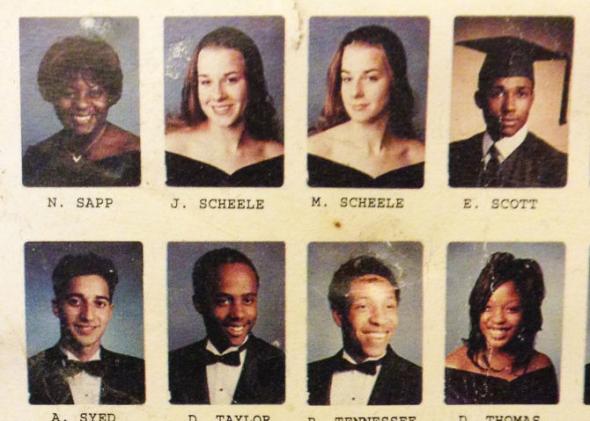Why Serial Can’t Settle on a Genre

Page from Woodlawn High School yearbook courtesy ofThis American Life
Hear Katy Waldman discuss Episode 9 of Serial with David Haglund and Willa Paskin.
As Serial has progressed, it has become less obvious what exactly the podcast is about. Defining itself as it goes along is part of the show’s appeal, but it also makes listening feel precarious: Every week you tune in and wonder whether you’ll hear a murder mystery, a crime procedural, or a pensive character study. And then there are the minisections patched into the larger fabric, like this week’s standalone, deeply emotional memorial to Hae Min Lee, or the one-off wacky comedy sketch between host Sarah Koenig and fellow producer Dana Chivvis. The show swerves between genres, counting on Koenig’s warm and relatable persona to weave it all together. Serial may not end up in the place it originally intended—its form may be more dictated by the facts of the case than even the TAL team anticipated—and maybe that structural wavering is part of the point.
I’d argue that Serial doesn’t know what it is because it doesn’t yet know how it ends. (St. Augustine was the first of many autobiographers to note the contradiction of narrating a life that’s still unfolding.) The show lies more or less at the mercy of the real-life story it has set in motion, with fresh characters and information—like new testimony from the victim’s high school friends, or the nonexistence of a crucial phone booth—materializing all the time.
At first, the podcast seemed to promise a straightforward detective tale. Koenig’s mission was to reinvestigate Lee’s murder and find out whether Adnan Syed was wrongfully imprisoned. She did such sleuth-like things as retracing the prisoner’s alleged movements in her car and speaking to his friends to get ideas for possible motives. She followed leads—a school custodian, a neighbor boy—and pored over police records and phone charts. She began to construct the beginnings of a counter-narrative, positioning Syed’s “ex-friend” Jay as a possible suspect. In these first episodes, Serial oriented itself around the central mysteries of what happened and why—mysteries with answers that exist, enticingly, in the universe, whether or not we ever find them.
But, nine episodes in—with three, apparently, to go—the minutiae Koenig threw at us has yet to cohere into a new version of events. And the focus, in the last few weeks, has begun to shift, as if the show were trying to subtly abandon a question it had lost confidence in its ability to answer. So the pure whodunit morphed into an investigation into the workings of the criminal justice system. We heard from Deirdre Enright of the Innocence Project, who called the jury’s guilty verdict into question. We listened to clips of the defense attorney haranguing Jay in a way that cast serious doubt on the attorney’s competence and wondered at Syed’s choice not to testify. It felt to me like Serial had swapped out one burning quandary for another: Instead of “What happened?” it asked, “What will happen?” Could Syed be exonerated?
Except we’ve reached an aporia here too. Serial’s creators don’t know what the Innocence Project will uncover—according to CJR, the group is just now filing for permission to run forensic tests. And they don’t know how the levers of law enforcement will respond to the results if and when they come. Koenig and her team can set the stage for a grand reversal of institutional injustice, but that’s about it. With respect to the what-will-happen plotline, they appear to have reached another stalemate.
Which may be why, in the most recent installment, Serial shape-shifted once more. Episode nine takes the podcast into new territory: Rather than sifting through past evidence, or assessing future outcomes, it paints a portrait of Adnan Syed as he was during the investigation and trial and as he is today. Koenig, no longer a detective or a legal activist, emerges as a close observer of character, somewhere between a witness and a novelist. The idea seems to be that, even if we never find out whodunit (seemingly the original raison d’etre of the show), or whether Adnan will rejoin society (pressing question number two), our time will have been well spent getting a sense of this world and story.
That’s a worthwhile project, but perhaps not what listeners were led to expect by the feverish information gathering of the initial episodes. Serial’s priorities now appear to lie in the domain of character and milieu rather than investigative journalism. Of course, depending on how the facts shake out, it could switch gears at any moment. Maybe fluidity of form is what you get when you decide to embrace the thrill—and risk—of spinning out your podcast in real time. The reason I don’t feel cheated by this latest shift—or by the genre instability of the show as a whole—is that I think there’s a deeper meaning to the way Serial has moved from a project that requires answers and resolutions to one that doesn’t. Maybe the uncertainty is even a small rebuke to us overeager fans, as if the powerlessness in not knowing might bend our minds back to one of the only things we know for sure: that a young woman, Hae Min Lee, was taken from her friends and family forever.
